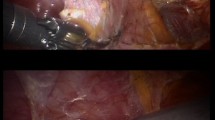Abstract
Purpose
Kidney transplantation is the preferred treatment for patients with end-stage renal disease. In order to reduce the morbidity of the open surgery, a robotic-assisted approach has been recently introduced. According to the published literature, the robotic surgery allows the performance of kidney transplantation under optimal operative conditions while maintaining the safety and the functional results of the open approach.
Methods
We present the case of a mother donating to her daughter affected by end-stage renal disease (ESRD) due to Alport disease (creatinine: 353 umol/l; GFR: 13 ml/min per 1.73 m2).
Results
A robotic-assisted kidney transplant (RAKT) was successfully performed. Surgical time was 120 min with 53 min for vascular suture. The estimated blood loss was <50 cc. The kidney started to produce urine intra-operatively with a rate of 250 cc/h, which remained constant over the next hours. During the first postoperative day, the patient was ambulating and started oral intake. Pain was minimal, and no analgesia was required after 48 h. Serum creatinine improved progressively to 89 umol/l on postoperative day 3. No surgical complications were recorded, and the patient was sent home on postoperative day 5.
Conclusion
We present the first Spanish transperitoneal pure RAKT from a living-related donor. We believe this is the second pure robotic-assisted kidney transplantation case performed in Europe. We believe that the potential advantages of RAKT are related to the quality of the vascular anastomosis, the possible lower complication rate and the shorter recovery of the recipients.


Similar content being viewed by others
Abbreviations
- dVSS® :
-
Da Vinci Surgical System®
- ESRD:
-
End-stage renal disease
- EIV:
-
External iliac vessels
- GFR:
-
Glomerular filtration rate
- KT:
-
Kidney transplantation
- LDN:
-
Laparoscopic donor nephrectomy
- MIS:
-
Minimally invasive surgery
- RAKT:
-
Robotic-assisted kidney transplantation
- tRAKT:
-
Transperitoneal robotic-assisted kidney transplantation
References
Maroz N, Simman R (2013) Wound healing in patients with impaired kidney function. J Am Coll Clin Wound Spec 5:2–7. doi:10.1016/j.jccw.2014.05.002
Collins AJ, Foley RN, Chavers B et al (2012) United States renal data system 2011 annual data report: atlas of chronic kidney disease and end-stage renal disease in the United States. Am J Kidney Dis Off J Natl Kidney Found 59(A7):e1420. doi:10.1053/j.ajkd.2011.11.015
Murray JE, Merrill JP, Harrison JH (1958) Kidney transplantation between seven pairs of identical twins. Ann Surg 148:343–359
Ratner LE, Ciseck LJ, Moore RG et al (1995) Laparoscopic live donor nephrectomy. Transplantation 60:1047–1049
Øyen O, Scholz T, Hartmann A, Pfeffer P (2006) Minimally invasive kidney transplantation: the first experience. Transplant Proc 38:2798–2802. doi:10.1016/j.transproceed.2006.08.102
Rosales A, Salvador JT, Urdaneta G et al (2010) Laparoscopic kidney transplantation. Eur Urol 57:164–167. doi:10.1016/j.eururo.2009.06.035
Menon M, Tewari A, Peabody J, Team VIP (2003) Vattikuti Institute prostatectomy: technique. J Urol 169:2289–2292. doi:10.1097/01.ju.0000067464.53313.dd
Yuh B, Wilson T, Bochner B et al (2015) Systematic review and cumulative analysis of oncologic and functional outcomes after robot-assisted radical cystectomy. Eur Urol 67:402–422. doi:10.1016/j.eururo.2014.12.008
Giulianotti P, Gorodner V, Sbrana F et al (2010) Robotic transabdominal kidney transplantation in a morbidly obese patient. Am J Transplant Off J Am Soc Transplant Am Soc Transpl Surg 10:1478–1482. doi:10.1111/j.1600-6143.2010.03116.x
Doumerc N, Roumiguié M, Rischmann P, Sallusto F (2015) Totally robotic approach with transvaginal insertion for kidney transplantation. Eur Urol. doi:10.1016/j.eururo.2015.07.026
Menon M, Sood A, Bhandari M et al (2014) Robotic kidney transplantation with regional hypothermia: a step-by-step description of the Vattikuti Urology Institute-Medanta technique (IDEAL phase 2a). Eur Urol 65:991–1000. doi:10.1016/j.eururo.2013.12.006
Riedmiller H, Gerharz EW (2008) Antireflux surgery: Lich-Gregoir extravesical ureteric tunnelling. BJU Int 101:1467–1482. doi:10.1111/j.1464-410X.2008.07683.x
Trinh Q-D, Sammon J, Sun M et al (2012) Perioperative outcomes of robot-assisted radical prostatectomy compared with open radical prostatectomy: results from the nationwide inpatient sample. Eur Urol 61:679–685. doi:10.1016/j.eururo.2011.12.027
Giedelman CA, Abdul-Muhsin H, Schatloff O et al (2013) The impact of robotic surgery in urology. Actas Urol Esp 37:652–657. doi:10.1016/j.acuro.2012.11.015
Burgos FJ, Pascual J, Quicios C, et al. (2006) Post-kidney transplant surgical complications under new immunosuppressive regimens. Transplant Proc 38:2445–2447. doi:10.1016/j.transproceed.2006.08.192
Hoznek A, Zaki SK, Samadi DB et al (2002) Robotic assisted kidney transplantation: an initial experience. J Urol 167:1604–1606
Boggi U, Vistoli F, Signori S et al (2011) Robotic renal transplantation: first European case. Transpl Int Off J Eur Soc Organ Transplant 24:213–218. doi:10.1111/j.1432-2277.2010.01191.x
Tsai M-K, Lee C-Y, Yang C-Y et al (2014) Robot-assisted renal transplantation in the retroperitoneum. Transpl Int Off J Eur Soc Organ Transplant 27:452–457. doi:10.1111/tri.12279
Authors’ contribution
A Breda involved in project development and data analysis and wrote the manuscript, surgeon. L. Gausa involved in project development, surgeon. A. Territo involved in data collection and data analysis and wrote the manuscript. J. M. Lopez-Martinez involved in data collection and data analysis and wrote the manuscript. Surgeons O. Rodriguez-Faba, J. Caffaratti, and J. Ponce de León involved in data supervision and L. Guirado involved in data collection and data analysis. H. Villavicencio supervised the study.
Author information
Authors and Affiliations
Corresponding author
Ethics declarations
Conflict of interest
The authors declare that they have no conflict of interest.
Rights and permissions
About this article
Cite this article
Breda, A., Gausa, L., Territo, A. et al. Robotic-assisted kidney transplantation: our first case. World J Urol 34, 443–447 (2016). https://doi.org/10.1007/s00345-015-1673-6
Received:
Accepted:
Published:
Issue Date:
DOI: https://doi.org/10.1007/s00345-015-1673-6




